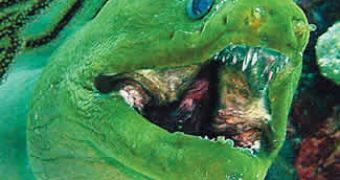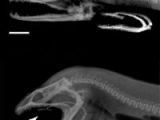Moray eels are damn ugly fish and they could be a source of inspiration for many horror and SF movie characters. Over 200 species dwell in tropical seas worldwide, inhabiting holes in rocks and coral reefs. These eels can scare the hell out of novel scuba divers, as some can reach 10 feet (3 m) in length and display a grin filled by large sharp teeth. There's no reason, as this fish won't attack people as prey (but they will defend themselves).
But their odd look is accompanied by a SF method of feeding, as found by a UC Davis. After grabbing prey in its toothed jaws, a second set of jaws found in the moray's throat reaches forward into the mouth and displaces the food to the esophagus for swallowing.
"This is really an amazing innovation for feeding behavior for fishes in general. The research shows the amazing diversity possible among living things, even in something as fundamental as feeding," said co-author Rita Mehta, a postdoctoral researcher in the Section of Evolution and Ecology at UC Davis.
A high-speed digital camera recorded the eels feeding in the lab, capturing the quick movement of these secondary pharyngeal jaws. X-ray and other imaging techniques revealed the way the jaws could move.
Most fish swallow the food by suction. When it reaches the food or prey, the fish rapidly increases the volume of its mouth cavity, sucking in water and the food found in it. The water is expelled through the gills openings, the food is passed to the esophagus.
Some species overtaking prey with their mouth open or grab it in their jaws, but the majority have to employ suction to send the food from the mouth to the esophagus.
But moray eels, hunting in confined spaces, cannot rapidly expand their mouths to create suction and as a result they had to evolve another method. They first immobilize prey with their powerful, toothsome outer jaws and then the pharyngeal jaws, armed with large, curved teeth, moves forward and grabs it.
In this moment, the outer jaws release the prey and the back jaws send it back to the esophagus, all this is a fraction of a second.
"Other fish are known to have pharyngeal jaws that can grind or crush food (e.g. Carps and relatives), but nothing this spectacular," said co-author Peter Wainwright, professor of evolution and ecology at UC Davis.
Only in the moray eel there is a second, mobile set of pharyngeal jaws. When resting, the pharyngeal jaws remain located behind the eel's skull, inside its throat and when in action, they will move almost the length of the animal's skull, but won't go beyond the outer jaws.
Other species of eels, like the freshwater eels, so much appreciated in the European cuisine and conger eels, feed by suction.

 14 DAY TRIAL //
14 DAY TRIAL // 
